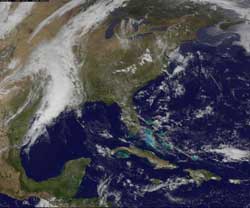NASA sees more severe weather over eastern Texas, Oklahoma

NOAA's GOES-13 satellite captured a visible image of the clouds associated with the stalled front over eastern Texas and Oklahoma on March 20, 2012 at 1731 UTC (1:31 pm EST). Ironically, the clouds look almost like a giant funnel. Credit: NASA/NOAA GOES Project<br>
NASA's Aqua satellite and NOAA's GOES-13 satellite have been providing infrared, visible and microwave images to forecasters of the stalled frontal system.
On March 20, a flood warning was in effect up and down the eastern sides of Texas and Oklahoma, including Dallas and Fort Worth, Texas. The National Weather Service posted a flood warning for the double cities because of heavy rainfall over the last 36 hours. More isolated thunderstorms are expected to develop late afternoon and evening, generating more heavy rainfall, lightning and small hail.
When NASA's Aqua satellite flew over the low pressure area on March 20 at 0753 UTC 34:53 a.m. EST), the Atmospheric Infrared Sounder (AIRS) instrument onboard captured an infrared image that showed cloud top temperatures in the frontal system. The strongest thunderstorms, heaviest rainfall and coldest cloud top temperatures (around 220 Kelvin/ -63.6 F/-53.1 C) appeared as a giant wedge over the region.
NASA's Goddard Space Flight Center in Greenbelt, Md. uses data from the National Oceanic and Atmospheric Administration's (NOAA's) GOES-13 satellite's and creates images and animations. NOAA's GOES-13 satellite captured a visible image of the clouds associated with the stalled front over eastern Texas and Oklahoma on March 20, 2012 at 1731 UTC (1:31 p.m. EDT). Ironically, the clouds look almost like a giant funnel.
Media Contact
More Information:
http://www.nasa.govAll latest news from the category: Earth Sciences
Earth Sciences (also referred to as Geosciences), which deals with basic issues surrounding our planet, plays a vital role in the area of energy and raw materials supply.
Earth Sciences comprises subjects such as geology, geography, geological informatics, paleontology, mineralogy, petrography, crystallography, geophysics, geodesy, glaciology, cartography, photogrammetry, meteorology and seismology, early-warning systems, earthquake research and polar research.
Newest articles

Trotting robots reveal emergence of animal gait transitions
A four-legged robot trained with machine learning by EPFL researchers has learned to avoid falls by spontaneously switching between walking, trotting, and pronking – a milestone for roboticists as well…

Innovation promises to prevent power pole-top fires
Engineers in Australia have found a new way to make power-pole insulators resistant to fire and electrical sparking, promising to prevent dangerous pole-top fires and reduce blackouts. Pole-top fires pose…

Possible alternative to antibiotics produced by bacteria
Antibacterial substance from staphylococci discovered with new mechanism of action against natural competitors. Many bacteria produce substances to gain an advantage over competitors in their highly competitive natural environment. Researchers…





















